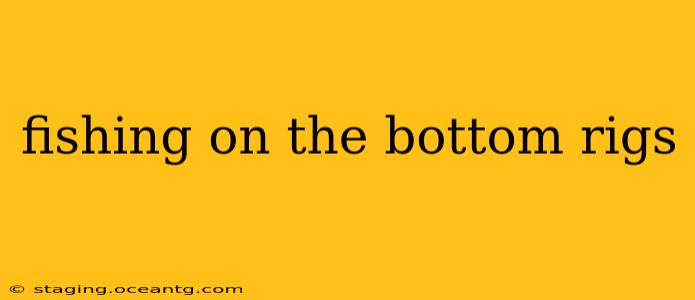Bottom fishing, the art of targeting fish dwelling near or on the seabed, is a rewarding angling pursuit. Whether you're after flatfish, cod, grouper, or other bottom-dwelling species, selecting and employing the right rig is crucial for success. This comprehensive guide dives deep into various bottom fishing rigs, their applications, and how to optimize your setup for maximum catches.
What are the Different Types of Bottom Fishing Rigs?
Several rigs excel at bottom fishing, each suited to specific conditions and target species. The best choice depends on factors like water depth, bottom structure, current strength, and the type of fish you're targeting. Here are some popular choices:
1. The Simple Bottom Rig:
This is the most basic setup, ideal for beginners and situations with minimal current. It typically consists of:
- Weight: A sinker (e.g., lead, tungsten) heavy enough to reach the bottom quickly.
- Swivel: Connects the main line to the leader, preventing line twist.
- Leader: A shorter length of monofilament or fluorocarbon line, offering abrasion resistance and improved stealth.
- Hook: A suitable hook size and style for your target species.
2. The Carolina Rig:
Excellent for covering ground and navigating snags, the Carolina rig features:
- Weight: A bullet weight slides freely on the main line.
- Swivel: Connects the weight to the leader.
- Leader: A longer leader (12-36 inches) allows the bait to move freely, enticing strikes.
- Hook: Usually a weighted hook to further enhance bottom contact.
This setup excels in areas with weeds, rocks, or other obstructions.
3. The Texas Rig:
Primarily used for freshwater bass fishing, but adaptable to saltwater species, the Texas Rig features:
- Weight: A bullet weight is pegged onto the line, preventing it from sliding freely.
- Hook: A weighted hook with a weed guard to help prevent snags in heavy cover. The bait is often rigged on the hook, creating a natural presentation.
The weed guard is particularly beneficial in weed beds or other heavy cover areas.
4. The Drop Shot Rig:
This sensitive rig allows for precise bait placement and works well in various depths:
- Weight: A small weight is tied to the end of the main line.
- Hook: A hook is tied to the main line above the weight, allowing the bait to hover freely at a specific depth.
The Drop Shot is excellent for vertical jigging and targeting fish suspended above the bottom.
5. The Fishfinder Rig:
Designed for detecting and attracting fish, the Fishfinder rig uses a series of beads and swivels to create a more visually appealing presentation:
- Weight: Typically a sliding weight is incorporated for efficient bottom contact.
- Swivels & Beads: These create noise and visual attraction, alerting fish to your bait.
- Leader: A shorter leader attached to the main line.
- Hook: A suitable hook for your target species.
This rig is effective in clearer waters where visual appeal is important.
What is the Best Weight for Bottom Fishing Rigs?
The appropriate weight depends on several factors including current strength, water depth, and bottom type. In strong currents, a heavier weight is necessary to keep your bait on the bottom, while lighter weights suffice in calm waters. Experimentation is key to finding the sweet spot for optimal presentation.
What Size Hook Should I Use for Bottom Fishing?
Hook size is dictated by the size of your bait and the size of the fish you're targeting. Generally, use a hook size that allows you to comfortably hook and land your target species without it being too big or too small.
How Do I Choose the Right Bait for Bottom Fishing?
Bait selection is as critical as rig selection. Consider the target species and their feeding habits when choosing your bait. Live bait like worms, shrimp, or small fish are highly effective, while artificial lures like jigs, plastic worms, or soft baits can be equally productive.
What is the Best Line for Bottom Fishing?
Using the appropriate line is crucial for success. A heavier line is necessary in areas with heavy cover or snags to prevent breakages, while lighter lines allow for more delicate presentations. Consider braid for its sensitivity and strength, or monofilament for its abrasion resistance.
By understanding the various bottom fishing rigs and employing the appropriate techniques, you can significantly improve your chances of success. Remember, experimentation is crucial; try different rigs, weights, and baits to find what works best in your specific fishing conditions. Happy fishing!
